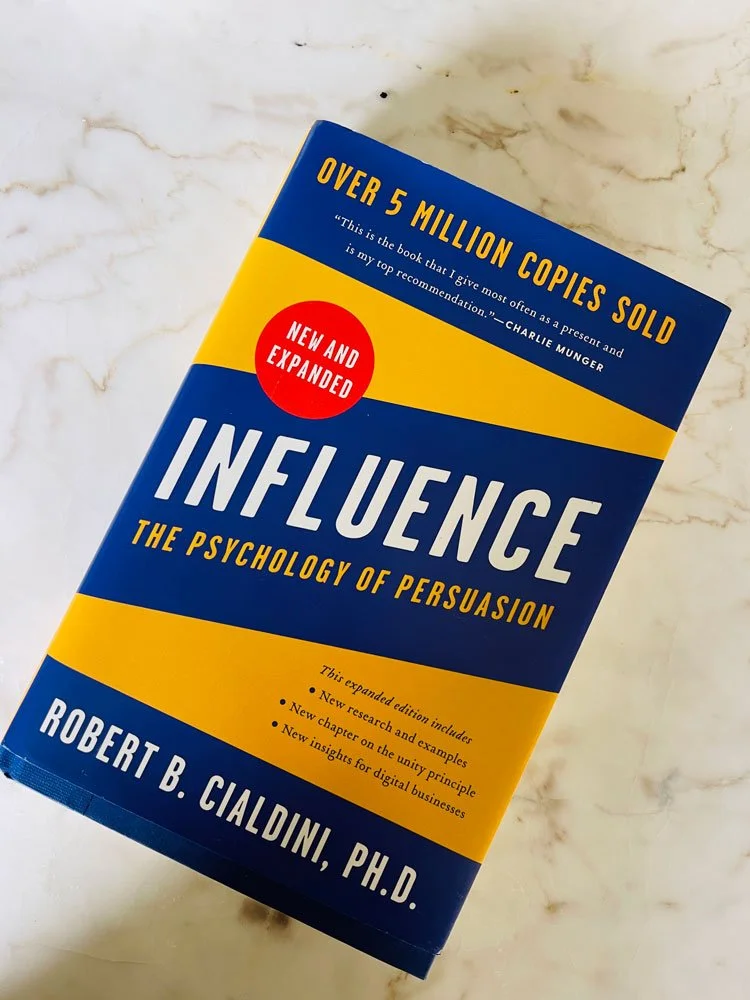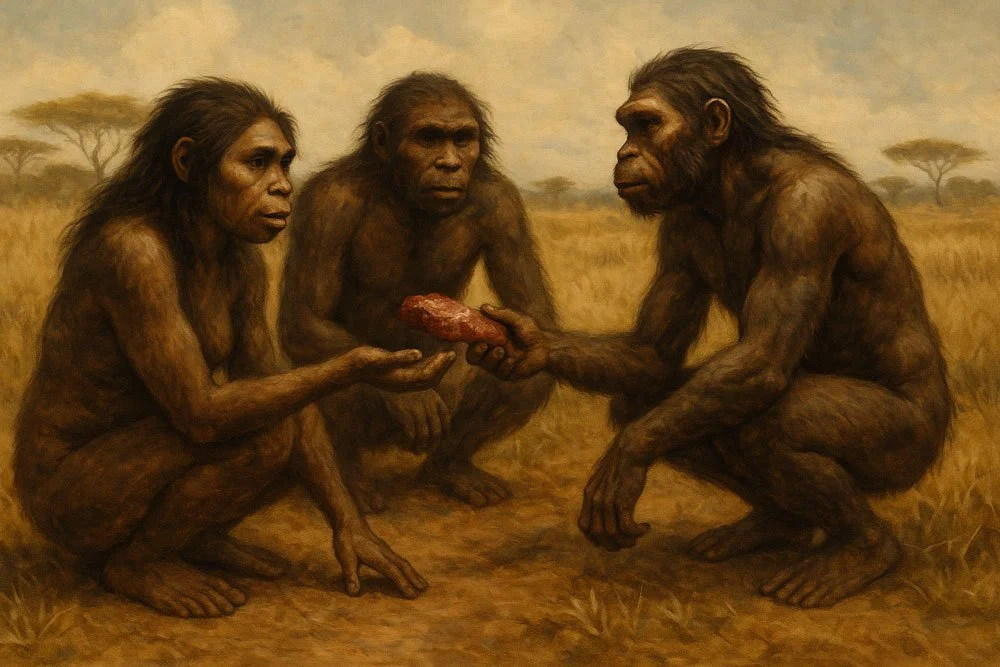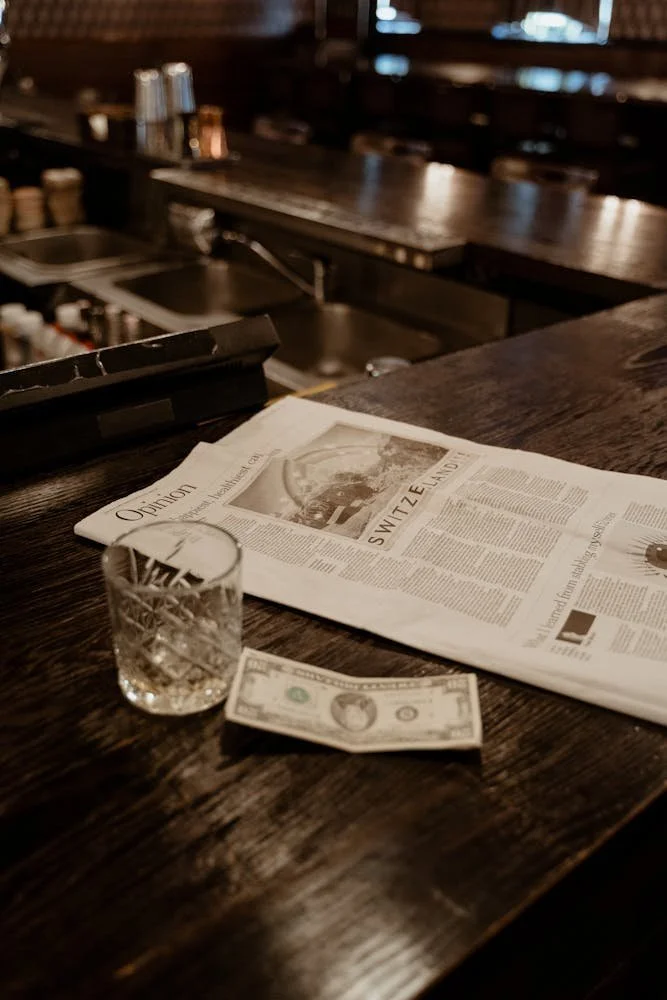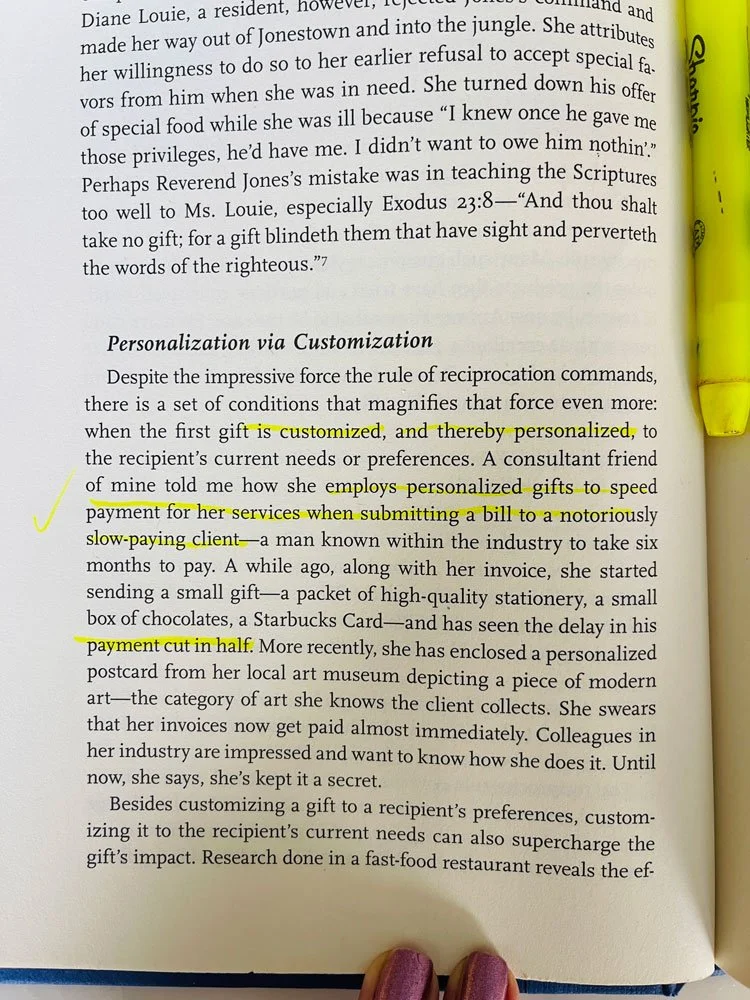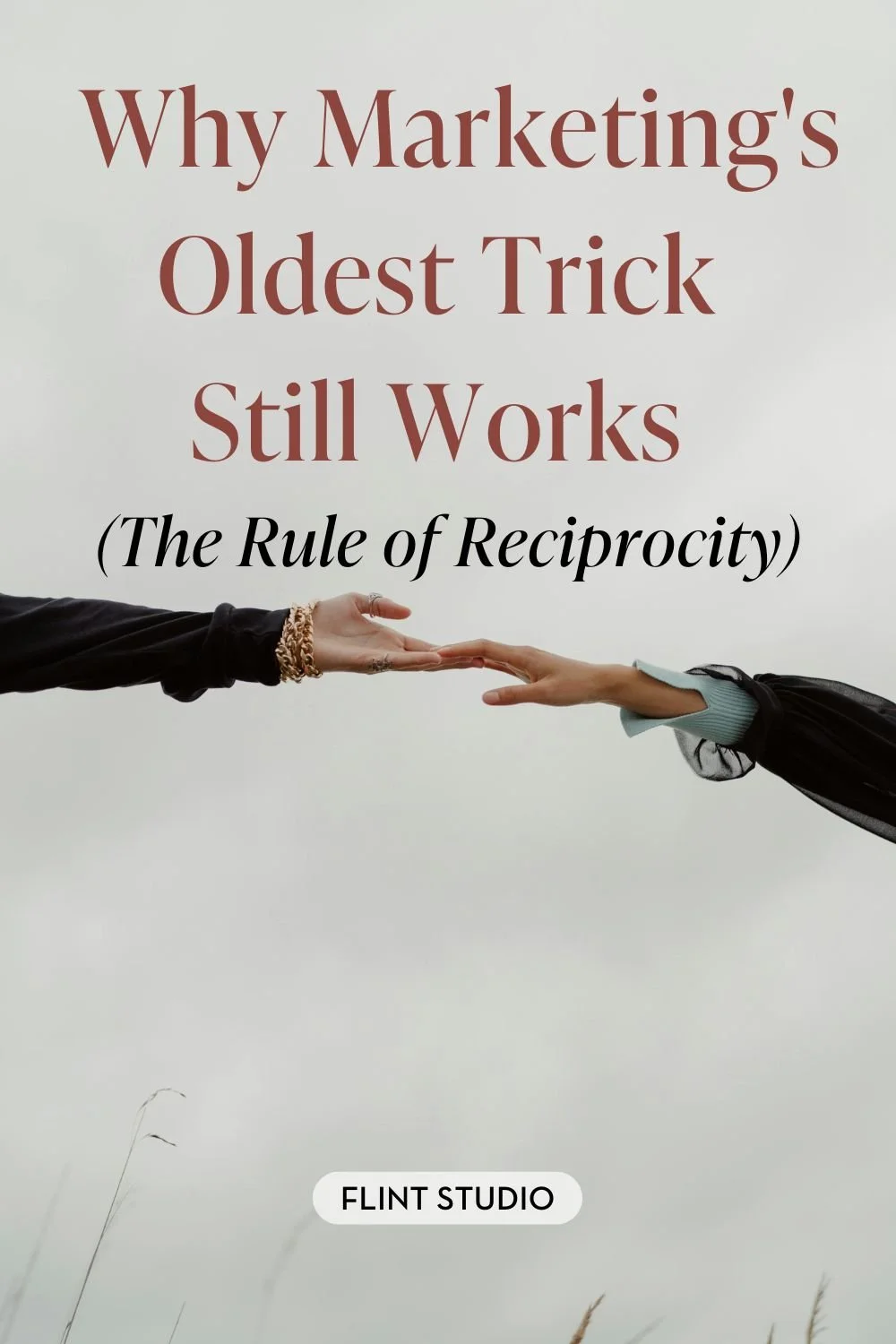The Rule of Reciprocity - Marketing's Oldest Trick Still Works
This is my weekly newsletter, Market Smarter, Not Harder💡posted to my blog. If you’d like to join the conversation and have it delivered straight to your inbox, click here.
What Is the Reciprocity Principle?
The Rule of Reciprocity says this: when someone gives us something - whether it’s a gift, favor, or generous act - we feel an internal obligation to give something back.
Reciprocity isn’t just good manners, it’s evolutionary strategy
In Robert Cialdini’s book Influence: The Psychology of Persuasion he explains that we are hard-wired to respond positively to a gift, even when we didn't ask for it. We feel gratitude, which leads to feeling indebted to the giver.
This isn’t armchair psychology, it’s hardwired in human evolution for survival.
As social creatures, early humans relied on cooperation to survive. Sharing resources, warning others of danger, and helping care for children that weren’t your own meant you were more likely to be protected and supported in return.
Over time, this “give-and-get” behavior became hardwired into our psychology.
The people who took but didn’t return favors? They were shunned and left without the group’s protection, which was essentially, a death sentence.
That ancient wiring still lives in us today.
Even some non-primates perform reciprocity - crows (those clever birds!) are known to leave gifts for people who put out food for them such as pebbles, twigs, or the proverbial “shiny objects” like coins or buttons. Additional animals include other primates, vampire bats, Norwegian rats, and more.
Crow gifts, Jordan Schmidt
So whether it’s a neighbor helping carry groceries, a friend offering career advice, or a brand giving you a genuinely useful resource—we’re wired to feel like we owe them something in return.
“It may not happen the next day, but you’ve basically put money in the bank.”
Psychologist Robert Cialdini, author of Influence: The Psychology of Persuasion.
How the Reciprocity Principle can help market your business
Give. Give. Give. Get.
Your audience knows you’re running a business. They expect to be sold to at some point. It’s just a question of balance: how much do you give before you ask?
When you consistently show up with real value - whether that’s sharing helpful content, answering questions, or offering free resources that actually solve problems, you build goodwill. You shift from being “just another business” to a trusted guide.
Then, when you finally make the ask - whether it’s for a sign-up, a sale, or a share - your audience is far more likely to say yes because the trust you’ve earned makes “the yes” feel natural.
The Rule of Reciprocity as marketing strategy:
The Reciprocity Rule & your lead magnet
This may seem like an obvious one - the free lead magnet - but let’s talk about it for a minute.
In addition to the free, helpful content you provide that initially attracts a potential client into your sphere, the first “ask” is often a lead magnet freebie.
The clear rule here is to make your lead magnet worth it.
If your potential client has trusted you with their valuable email address and your freebie feels like an afterthought, you’ve broken the trust before the relationship even begins.
I still remember being disappointed by a lead magnet I downloaded years ago. I don’t know why I remember such a minor event except I know I also felt surprised. The quality of the content I’d seen so far from this business was high. She’s also not in business anymore, so that freebie may have been an indicator.
Consider this example:
Imagine a financial strategist who offers a “Free Monthly Budget Template.” But once downloaded, it’s just a skimpy, generic spreadsheet with no instructions. Not so helpful.
Now contrast that with a version that includes:
Pre-built categories
A short Loom video walking through how to use it
A bonus tab with savings goals and a cash flow calculator
That second version doesn’t just check a box. It helps someone solve a problem.
Your lead magnet should make them think, “If this is what she gives away for free... I bet her paid offer is pretty great.”
So whatever you’re giving away for free, make it valuable. Many say make your free material so valuable others would pay for it.
Here’s my targeted advice: Make sure it solves an immediate problem faced by your ideal client in an actionable way that aligns with your paid offer.
Make it quick to consume and quick to take action on. Give them a “quick win” and they will remember you for it and your brand will have achieved the “Halo Effect”.
Speaking of lead magnets, here’s one of mine for your consideration.😊
Reciprocity is even more powerful with personalization
GIVE SOMETHING UNEXPECTED & PERSONAL
One of Robert Cialdini’s most cited examples of reciprocity in action comes from a study involving restaurant waitstaff.
When waitresses left a single mint with the check, tips increased by around 3%. When they left two mints, tips jumped by 14%. But when they gave one mint, started to walk away, then turned back to offer a second mint while saying something like “for you, because you’ve been great,” tips soared by 23%.
The act of giving, especially when it felt thoughtful or personalized, triggered a strong urge to reciprocate, even in a brief transaction. It’s a powerful reminder that how you give matters in addition to what you give.
So knowing that personalizing makes it even more powerful, let’s look at how that can be applied to your marketing strategy:
The Reciprocity Rule & personalized client onboarding
Once you get the client (partly because of your fantastic freebie) it’s time to surprise and delight with a positive onboarding experience.
Super entrepreneur Leila Hormozi discusses at length the importance of proper onboarding. Basically she says ‘If you don’t think you can afford the time for proper onboarding, think again - you can’t afford not to.’ (paraphrase) She’s referring to employees, but we can apply it to clients and customers.
If someone signs on to work with you or purchases a product - digital or physical, make them feel welcome and valued. That’s where reciprocity becomes even more powerful: when it’s personalized.
A generic confirmation email is expected. But a handwritten thank-you card, a small welcome gift, or a personal Loom video recorded just for them? That’s memorable.
It communicates, “I see you. I appreciate you.” And because it feels thoughtful and unexpected, it taps directly into the Reciprocity Principle.
That simple gesture can turn a one-time client into a long-term fan - not just because of what you delivered, but how you made them feel right at the beginning of the experience.
(For more on how to cultivate loyalty in your audience, I highly recommend Pat Flynn’s book ‘Superfans’ - its a great read and not that long.)
That new client or customer now feels a connection to you that the automated email alone can’t achieve. They are much more likely to have positive thoughts about your brand, and reciprocate in some way:
They will be less likely to feel dissatisfaction or ‘buyer’s remorse’ and ask for a refund
They will be more likely to feel loyal to your brand and make other purchases or leave a favorable testimonial when asked
The Reciprocity Rule & client offboarding (e.g. - get paid faster)
Another striking example of the power of personalization for the Reciprocity Effect is how a consultant friend of Cialdini’s uses it to speed payment for her services. When it’s time to send invoices, she sends personalized gifts to speed up payment from her clients.
She managed to cut the payment timeframe in half for a man notorious in her industry for being a slow payer who sometimes took as long as six months!
How? She included a small gift like quality stationary or chocolates, and even a Starbucks card with her invoice.
Pretty amazing how a relatively small gesture can pay back with such dividends, right?
Robert Cialdini’s ‘Influence - The Psychology of Persuasion’ discussing how personalization via customization helps a consultant friend get paid faster when offboarding her clients.
Another way to use reciprocity - referral programs
What actually inspired this post was lunch yesterday. My friend is a landscape architect - we used to work at the same firm. She still has a W-2 job and is doing some landscape design work on the side.
I still get requests for landscape design because of the SEO (search engine optimization) power of my blog, Greenhouse Studio. I’ve been passing those referrals on to her and she’s gotten several jobs from them.
We meet for lunch periodically and yesterday was one of those days. At the end she wanted to buy my lunch because of a recent project. I wasn’t expecting it, but it was nice. (And nicer because it gave me this week’s blog and newsletter topic!)
Many service providers have formal referral programs. ‘You scratch my back and I’ll scratch yours’ so to speak. The phrase is casual, but the psychology behind it is powerful.
Referrals aren’t just a nice gesture, they’re often your best leads.
People who come to you through a trusted recommendation already have a level of built-in trust and are more likely to be a good fit for your services.
That’s why acknowledging and rewarding referrals is a smart business move. It strengthens the relationship and increases the likelihood they’ll send more high quality leads your way.
A little appreciation goes a long way - and it keeps the reciprocity loop going strong.
The Reciprocity Rule - “If you scratch my back, I’ll scratch yours” - from primate behavior to modern business practices. - Getty images via Squarespace
The Reciprocity Principle isn’t just a psychology concept - it’s a practical, powerful way to build trust, deepen relationships, and grow your business with integrity.
When you lead with generosity, deliver unexpected value, and genuinely appreciate the people who support you, good things tend to come back around. Not always immediately, but like Cialdini says, sooner or later it’s money in the bank.
That's a wrap for this week!
P.S. - Let me know what you think in the comments below. Your feedback helps me create the best content to help you grow your business. 🙏🏻
Pin this for later!

